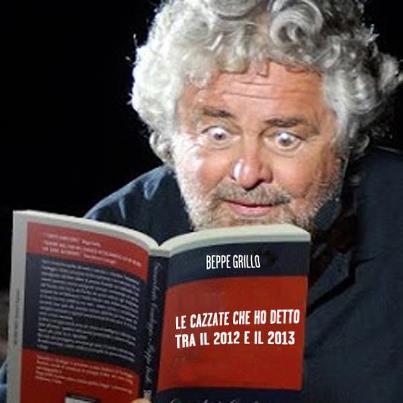 Political satire is once again front and center in Italy. Beppe Grillo, a political comedian recently won 25% of the current Italian election for his 5 Star Movement. This is the same Beppe Grillo who once organized an annual V Day (vaffanculo or the Italian version of F**k you), as a day of political protest against all politicians. His rallying cries against the wealthy and corrupt have finally taken the hearts of the Italian public and he has now joined those he once derided, hoping to make a change from the inside out. Grillo himself cannot serve because of a 1988 conviction but he is still the driving force behind the movement.
Political satire is once again front and center in Italy. Beppe Grillo, a political comedian recently won 25% of the current Italian election for his 5 Star Movement. This is the same Beppe Grillo who once organized an annual V Day (vaffanculo or the Italian version of F**k you), as a day of political protest against all politicians. His rallying cries against the wealthy and corrupt have finally taken the hearts of the Italian public and he has now joined those he once derided, hoping to make a change from the inside out. Grillo himself cannot serve because of a 1988 conviction but he is still the driving force behind the movement.
According to Beppe Grillo, every politician should be put in jail for a long time and everyone who voted for them should serve at least one day in prison. Of course, now that Grillo is himself a politician, will he, if needed, accept his own sentence?
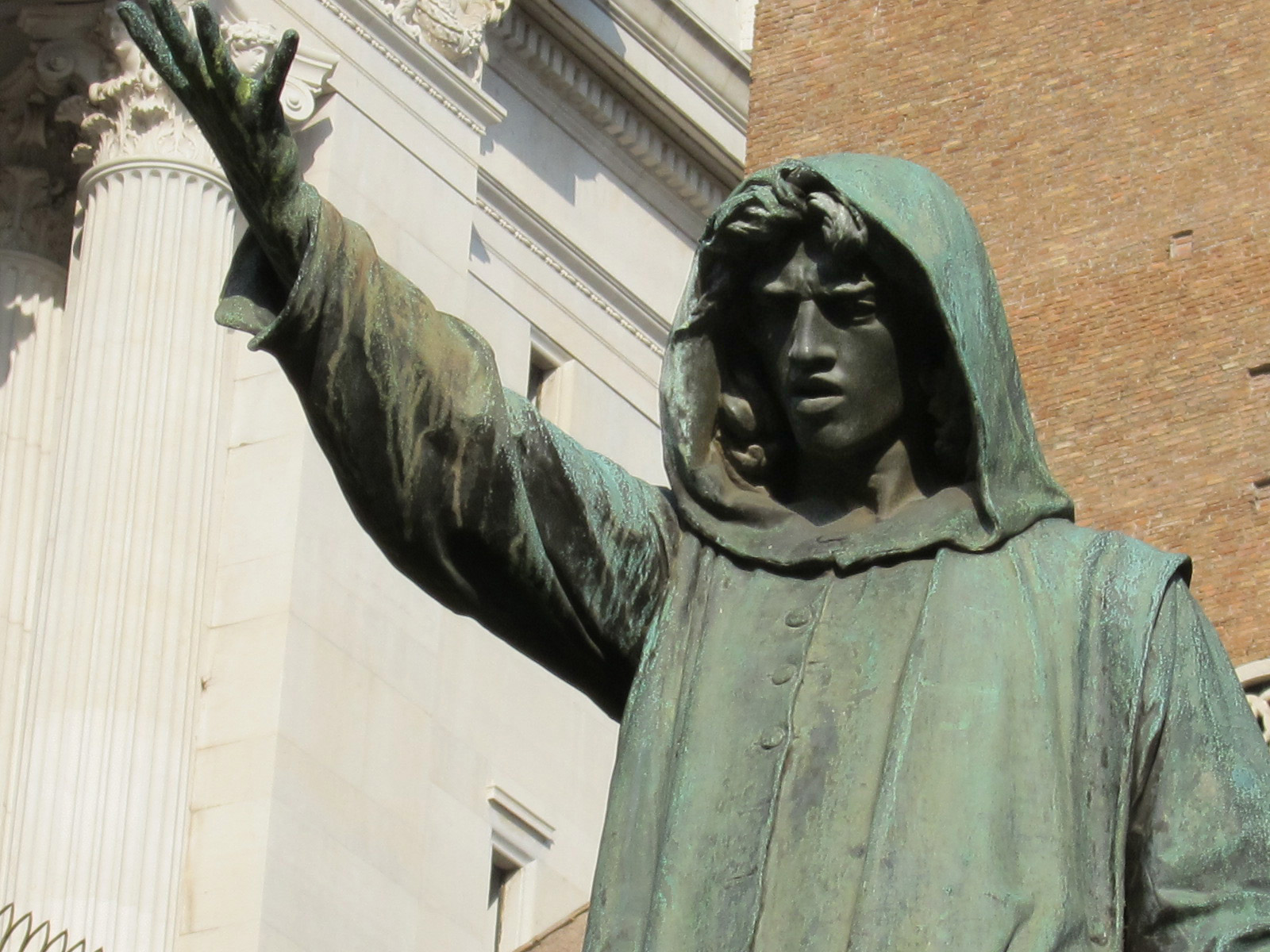 Walking up the steps to the Piazza del Campidoglio you can’t help but notice the statue of Cola di Renzo, the political activist who ignited the Italians into a revolt against the corruption of the wealthy ruling class of Rome in the 14th century. Di Renzo was eventually killed by an angry mob. We can only hope Grillo fares better.
Walking up the steps to the Piazza del Campidoglio you can’t help but notice the statue of Cola di Renzo, the political activist who ignited the Italians into a revolt against the corruption of the wealthy ruling class of Rome in the 14th century. Di Renzo was eventually killed by an angry mob. We can only hope Grillo fares better.
The Silvio Berlusconi years (about 20 years) were mostly a gift for political satirists. Berlusconi is such an easy mark (bunga-bunga sex parties, hair transplants, plastic surgery, sex scandals, tax evasion, buffoonery), but he also owns ½ of the television networks in Italy and has major stakes in newspapers, publishing, cinema, banking and sports. Whoever controls the media, controls the thoughts of the people. Berlusconi is also not a man who takes public ridicule easily. Comedians and cartoonists have been sued for slander and TV satire shows have been cancelled and subjected to a multi million euro lawsuits.
Even though most people in Italy think of Berlusconi as a bigger joke than Beppe Grillo, he still managed to win 30% of the recent election and his PDL party holds a majority in the Senate. All this for a man who was recently convicted of arranging a police wiretap on one of his political rivals, is currently in appeals on a tax fraud conviction and is set to got to trial on sexual offenses in March 2013.
Italy has always had a love/hate relationship with political satire. The people love it, the political powers hate it. I guess it’s never good to be on the pointed end of a barb.
The poet Horace skewered the Senate of Rome in the 1st century BC. The Decameron of Boccaccio and Divine Comedy of Dante are still great satirical commentary of 14th century Italy. Carlo Goldoni’s work with the “Commedia dell’Arte” skewered the wealthy Venetians of the 18th century. His 1753 play “The Servant of Two masters” has been recently restaged as “One Man, Two Guvnors” in London and New York. It’s still a big hit.
In the 16th and 17th centuries, Rome enjoyed the largest period of construction since the ancient Rome. The church and its benefactors grew wealthier. The people of Rome grew poorer. Baroque Popes created their legacy in new churches, public fountains, palaces and urban renewal. The people just wanted something to eat but unfortunately, the poor were successfully beaten down to a ‘seen but not heard” society. Public outbursts and slander against the Pope or the wealthy suffered severe punishment. Complaints against the ruling class were restricted to local taverns, homes or small gatherings of friends.
In 1501, a strange remnant of a 3rd century BC statue was pulled from an excavation near what is now Piazza Navona. Cardinal Oliviero Carafa, a great patron of the arts, saw the beauty of the classical carving, placed it on a plinth outside of his home, the Palazzo Orsini (now the Palazzo Braschi) and proclaimed it the centerpiece of his Feast of Saint Mark celebration on April 25th. He wrapped it up in the classical robes of a pagan god and invited all to attach epigrams to the statue in a kind of poetry competition.
The statue, now known as Pasquino, is the eroded, pollution scared, mutilated remnant of what is thought to be Menelaus, the King of Sparta (jilted by Helen of Troy) holding the dead corpse of the warrior Patroclus after he was killed by Hector of Troy.
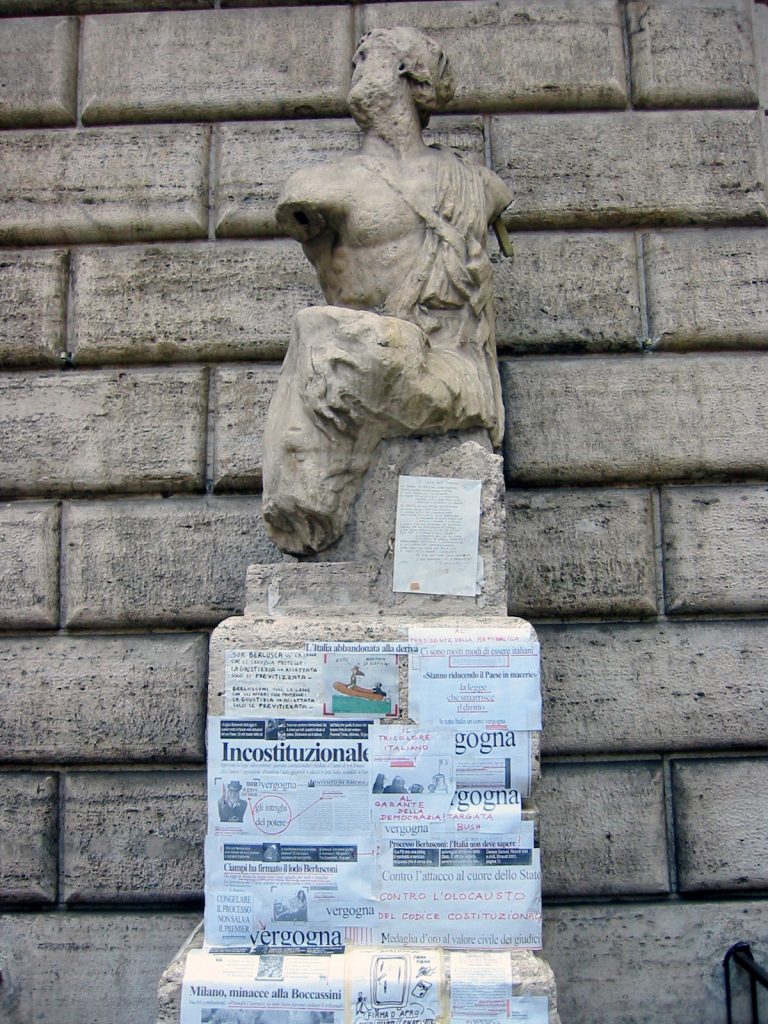 Some say it was named Pasquino because it was discovered around the time of Pasqua (Easter). It’s not a bad theory. Easter in 1501 was on April 11th. Cardinal Carafa’s Feast of Saint Mark was on April 25th.
Some say it was named Pasquino because it was discovered around the time of Pasqua (Easter). It’s not a bad theory. Easter in 1501 was on April 11th. Cardinal Carafa’s Feast of Saint Mark was on April 25th.
However, the most accepted legend is that his namesake was, in reality, a tailor who lived and worked in the neighborhood. The tailor Pasquino was good enough at his trade to be called to the Vatican on several occasions and consequently privy to some really good Vatican gossip. The tailor Pasquino was also renown for his great wit and acerbic tongue, entertaining his friends with wonderful barbs and anecdotes. The tailor Pasquino died a couple of years before Cardinal Carafa installed the old statue outside his palazzo. When the Feast of Saint Mark ended, the epigrams turned from poems of glorification to gossip, barbs and the political satire of the neighborhood. According the legend, the friends of tailor Pasquino passed his name onto the statue. He became the first of the “talking statues” of Rome.
Gianlorenzo Bernini once called Pasquino the finest sculpture he had ever seen. Of course, considering Pasquino was the symbol of irreverent satire and barbed insults, most likely Bernini was making a joke, as he was often known to do. It’s wonderful to know that even these days there are pompous historians who actually believe Bernini was offering praise on the worn carving in the same vein that Michelangelo praised the 1st century BC Belvedere torso of Hercules (now in the Vatican Museum). I truly doubt it.
Pasquino has been tossing out barbs, or pasquinades, as they are now called, for over 500 years. These days the small street corner on the side of Palazzo Braschi is known as the Piazza di Pasquino in his honor. He’s one of Rome’s most famous citizens.
There are 6 talking statues in Rome. They are known as “il Congresso degli Arguti”, the Congress of the Witty. They’ve been the public face of poets, satirists, political activists, anarchists, philosophers and more recently graffiti artists.
In the 1520’s The Dutch born Pope Adrian VI got so fed up with the insults, he threatening to throw Pasquino into the Tiber until one of his advisers told him that Pasquino, like a frog, would croak louder in the water. They just had to deal with the insults.
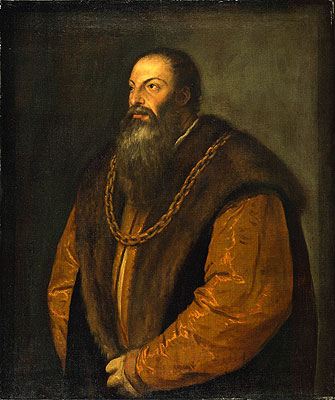
And there were many insults to deal with. The talking statues became the anonymous voice of many of the great writers. One of them was Pietro Aretino, the 16th century father of modern pornography. He said he was born a sodomite and he died from suffocation by laughing so hard. Between the two events, he was responsible for some of the best social commentary of the day. The image of Aretino here was painted by Titian.
Aretino’s main foils were Pope Leo X (Medici), Clement VII (Medici) and Adrian VI (Boeyens), who he referred to as “la tedesca tigna” (the German ringworm), although he was also smart enough to skip town and save his skin during Adrian V’s Papacy. One more interesting thing about Aretino. If you look at the image of St Bartholomew holding onto his skin in Michelangelo’s “Last Judgment” on the Sistine Chapel ceiling, the model for St Bartholomew is Pietro Aretino. He’s in the center of the painting.
Around 1532, someone once hung a tin cup on Pasquino with a message begging for alms to finish the Farnese palace when it was learned the Farnese family was having financial difficulties. The Palace was owned by Alessandro Farnese, who lost a lot of his fortune during the Sack of Rome in 1527. Farnese became Pope Paul III in 1534.
Pasquino also had a wonderful time with Guilia Farnese, Alessandro’s sister, calling her the ‘Bride of Christ” from her affair with Pope Alexander VI (Borgia).
The most famous of all the pasquinades was lanced in the early 1600s against Pope Urban VIII (Maffeo Barberini) when he had 200 tons of bronze removed from the beams of the entrance portico of the Pantheon to make 80 canons. The people were outraged at the rate the Popes were tearing down the ancient city.
“Quod non fecerunt barbari, fecerunt Barberini” (What the Barbarians didn’t do, the Barberini did)
Pope Urban VIII replied that the metal was better employed to keep the enemies away from the Holy See than to keep the rain off the Pantheon porch.
Pasquino became so popular that other neighborhoods created their own talking statues.
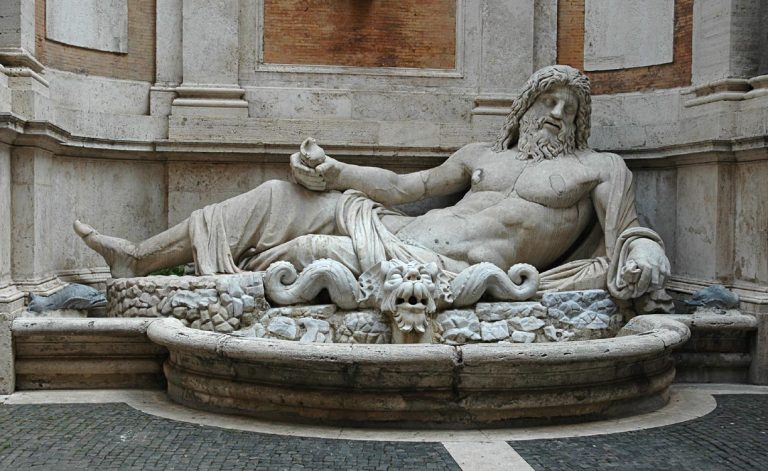 A reclining statue of the god Ocean was discovered in the Forum near the Mamertine Prison. He was moved the Piazza Colonna (just off the via del Corso) and then in 1588 he moved over to the Piazza San Marco (near the Palazzo Venezia), staying there a couple of years before moving to the Campidoglio in 1595. His name is Marforio, a name linking Mare (ocean) and Foro (forum). In the early 16th century Marforio and Pasquino became good friends, engaging in many famous dialogues.
A reclining statue of the god Ocean was discovered in the Forum near the Mamertine Prison. He was moved the Piazza Colonna (just off the via del Corso) and then in 1588 he moved over to the Piazza San Marco (near the Palazzo Venezia), staying there a couple of years before moving to the Campidoglio in 1595. His name is Marforio, a name linking Mare (ocean) and Foro (forum). In the early 16th century Marforio and Pasquino became good friends, engaging in many famous dialogues.
On the death of Pope Leo X in 1521:
Marforio: Why didn’t Leo take the sacrament on his deathbed?
Pasquino: How could he? He sold it.
Leo’s taste for luxury was legendary and in order to bring in the money he needed, he sold everything from Cardinal hats to indulgences, licenses for bars and prostitutes, palace furniture, dinner plates and holy objects of the Church.
In 1555, when Pope Paul IV (Giovanni Carafa), a famous persecutor of heretics, became Pope:
Pasquino: “Accidenti, che vino forte che c’è in questa carafa (My what strong wine there is in this carafe)
Marforio: “Ti sbagli, è aceto (you’re wrong it’s vinegar)
These days Marforio is locked up in the courtyard of the Palazzo Nuovo on the Campidoglio. Some say he was put there to keep him quiet.
 Madama Lucrezia, the only female of the statues, sits in Piazza San Marco, the same place that once was home to Marforio. She was found near the Temple of Isis near what is now the Church of Santa Maria Sopra Minerva, near the Pantheon. She is half of a 3rd century BC statue of the goddess Isis.
Madama Lucrezia, the only female of the statues, sits in Piazza San Marco, the same place that once was home to Marforio. She was found near the Temple of Isis near what is now the Church of Santa Maria Sopra Minerva, near the Pantheon. She is half of a 3rd century BC statue of the goddess Isis.
She is named for Lucrezia d’Alagno, the mistress of King Alfonso V of Naples who gave the statue to her as a gift. Alfonzo V gave Lucrezia a lot of really nice gifts, including the island of Ischia of the coast of Naples.
Around 1450 King Alfonso tried to get his marriage to Maria of Castille annulled so he could marry Lucrezia but the Pope refused. Nonetheless, Lucrezia was still considered the Queen of the Naples court, at least until 1458, when Alfonso died. The Kingdom of Naples was inherited by Ferdinand I, the son of Alfonso V and another mistress, Giraldona Carlino. Lucrezia became ‘persona non grata’. She was run out of Naples and moved to Rome, where she died a poor and broken women in 1479.
Madama Lucrezia was once part of the 18th century May Day celebrations when the poor would adorn her with necklaces of onions and carrots and dance the Ballo dei Povereti around her.
There isn’t too much attributed to her as a voice of “the Witty” but in 1799, when she fell over onto her face, someone attached a sign to her back that read: “I just can’t stand it any longer,” in reference to the failed attempt to form a Roman Republic. Pope Pius VI died in 1799 as a prisoner of Napoleon’s occupation of Rome. There was hope that the Papal succession would end and Rome would follow France in forming a Republic. It never happened. Pope Pius VII was elected in 1800. By the way, Pius VII wore a paper-mâché Papal hat during the ceremony because the official cap was still in the possession of the French.
Nearby, just up the Corso Vittorio Emanuele, in the Piazza Vidoni, to one side of the Basilica di Sant’Andrea della Valle, is the statue of Abbate Luigi. He is a toga clad statue of an ancient Roman dug up from the excavations of the nearby Theatre of Pompey. Luigi was originally placed next to the Chiesa del Santissimo Sudario, also in Piazza Vidoni. His name comes from Luigi, the Abbate of the Sudario church. According to legend, they looked a lot like each other.
Abbate Luigi (the statue) moved around the city over the years. He even spent some time in the courtyard of the Palazzo Chigi (now the residence of the Italian Prime Minister), a perfect place for a satirical talking statue.
He’s been at his current location since 1924, and just in case anyone forgot who he was, he was placed atop a plinth inscribed with the following poem:
Fui dell’antica Roma un cittadino (I was a citizen of ancient Rome)
Ora Abate Luigi ognun mi chiama (Now my name is Abbot Luigi)
Conquistai con Marforio e con Pasquino (With Marforio and Pasquino I won)
Nelle satire urbane eternal fama (eternal fame with urban satire)
Ebbi offese, disgrazie e sepoltura (I was offended, disgraced and buried)
Ma qui vita novella e alfin sicura (But here, my new life is safe at last)
The last line, “my new life is safe at last” is a rather dubious claim considering that his head has been decapitated, stolen and replaced many times over the years. After a decapitation in 1985, he was fitted with a concrete head. It looks a bit out of sort but cost a lot less than a stone version.
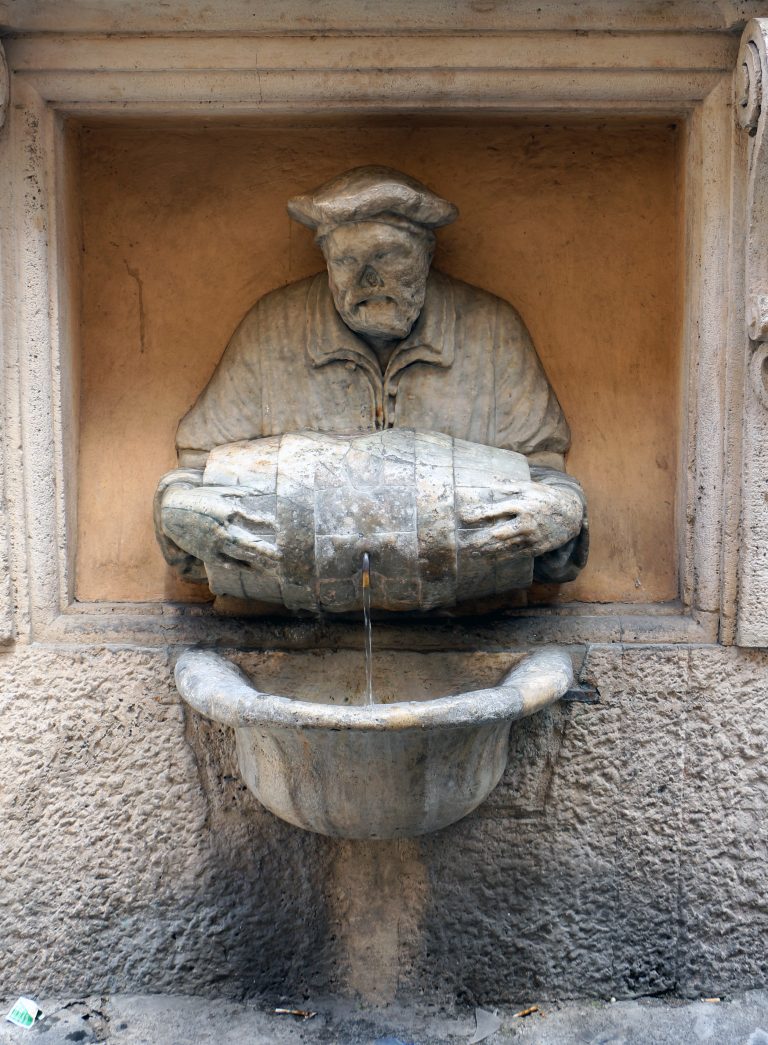 Il Facchino is another of the “lesser talking statues”. You can find him on the side of a building on via Lata, just off via del Corso. Facchino is a waterporter carved in 1580 by Jacopo del Conte, although there is one story that his face was carved by Michelangelo who made the face to resemble Martin Luther who lived nearby when he came to Rome in 1511. Facchino became famous because of his likeness to one Abbondio Rizzio, a man renown for the large amounts of wine and food he could consume.
Il Facchino is another of the “lesser talking statues”. You can find him on the side of a building on via Lata, just off via del Corso. Facchino is a waterporter carved in 1580 by Jacopo del Conte, although there is one story that his face was carved by Michelangelo who made the face to resemble Martin Luther who lived nearby when he came to Rome in 1511. Facchino became famous because of his likeness to one Abbondio Rizzio, a man renown for the large amounts of wine and food he could consume.
Water porters were popular in the 15th and 16th centuries. Although Pope Sixtus V did restore some of the ancient aqueducts, most people still got their drinking water delivered by porters who probably looked a lot like Facchino.
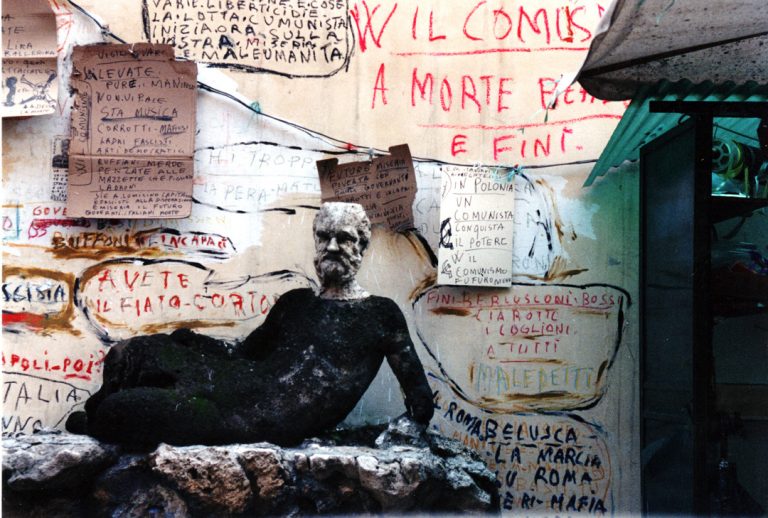
The last of the talking statues, and my personal favorite, is Il Babuino (the baboon) He lives on via Babuino, the fashionable street that runs from Piazza di Spagna to Piazza del Popolo. In 1525, the street was called via Clementina after Pope Clement VII (Medici). In 1534, the name was changed to via Paolina after Pope Paul III (Farnese). It was renamed via del Babuino soon after the fountain was erected in 1581. It’s funny to think that one of the most expensive shopping streets in Rome today is named after one of the ugliest statues in the city.
The fountain was built by a private citizen from Ferrara named Patrizio Grandi. As the story goes, when he obtained the water rights for his large estate in the area, by law, he needed to also provide a public fountain to the city.
No one knows if Grandi just had a warped sense of public art or if he was just pissed off at Pope Pius IV (Medici) for making him pay for the fountain. Whatever the rationale might be for building it, when it was completed, everyone hated it.

The design was built around the likeness of Silenus, a satyr and drunken friend of Dionysius (Bacchus). The head of the man and the body of the goat were from two different statues. The Romans thought it looked more like a like a baboon (an idiot, not a monkey) than a satyr (half man half goat). The water basin, a rectangular granite Roman bath basin, looks more like a small goldfish pond, both in shape and algae content.
One of the best quips (or babuinate) from Babuino came during Napoleon Bonaparte’s occupation of Rome in the late 18th century after the French came in and helped themselves to whatever they wanted.
Pasquino: “È vero che i francesi sono tutti ladri? (Are all the Frenchmen thieves?)”
Babuino: “Tutti no, ma BuonaParte” (not all but a good part of them)
The statue was removed in 1877, but thanks to the outcries of the Roman public, Babuino was reinstated in 1957.
The graffiti covered version above is from our visit to Rome in 1994. The clean version with me is from 2009. The wall behind him was painting with anti-graffiti paint. The graffiti might have come to an end but I’m sure Babuino will speak again soon.
Graffiti was a gift from the Romans although these days it’s become more of a curse.
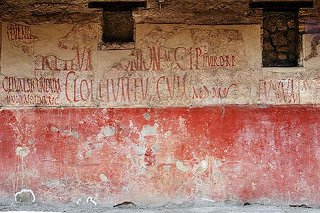 Historically we’ve learned a lot about the ancient Romans from their graffiti, some of it enlightening, like the Latin carvings in the 1st and 2nd century BC catacombs of Rome. Most of it is very similar to what we see today; new love, breakups, pornographic cartoons and witticisms, warnings, insults, political endorsements and philosophical jests.
Historically we’ve learned a lot about the ancient Romans from their graffiti, some of it enlightening, like the Latin carvings in the 1st and 2nd century BC catacombs of Rome. Most of it is very similar to what we see today; new love, breakups, pornographic cartoons and witticisms, warnings, insults, political endorsements and philosophical jests.
The best 1st century graffiti can still be seen in ruins of Pompeii.
At the Bar of Innulus and Papilio:
“Weep, you girls. My penis has given you up. Now it penetrates men’s behinds. Goodbye wondrous femininity.”
On the doorway of the House of Pacius Hermes:
“To the one defecating here. Beware the curse. If you look down on this curse, may you have an angry Jupiter for an enemy.”
Inside the House of the Centenary:
“Once you are dead, you are nothing.”
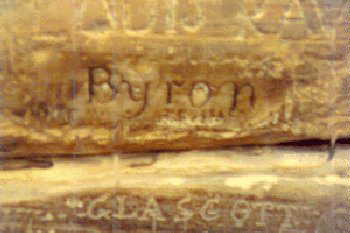 The opportunity to leave one’s name or comments has always been too strong to resist. Raphael carved his name into Nero’s Domus Aurea when it was rediscovered in the 15th century. Lord Byron scratched his name onto the Temple of Poseidon in Attica, Greece. We’ve seen countless old prisons with the names of the incarcerated scratched into the walls.
The opportunity to leave one’s name or comments has always been too strong to resist. Raphael carved his name into Nero’s Domus Aurea when it was rediscovered in the 15th century. Lord Byron scratched his name onto the Temple of Poseidon in Attica, Greece. We’ve seen countless old prisons with the names of the incarcerated scratched into the walls.
Small amounts of graffiti are interesting. Some of pieces are very clever and really wonderful. Unfortunately though, parts of Rome are now starting to look more like a post apocalyptic wasteland. It’s become a disease on the city architecture and infrastructure.
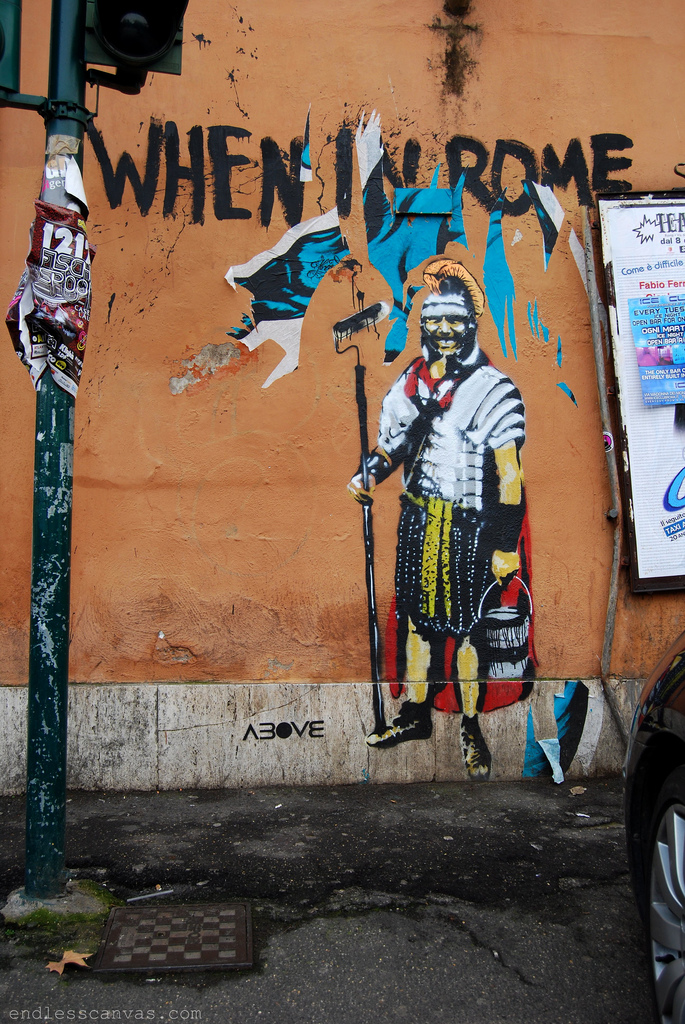 In 2010, Rome initiated a fight against graffiti. Anyone caught in the act is subject to a fine. Of course, in the true Rome tradition, there are some buildings that are still classified as OK to tag.
In 2010, Rome initiated a fight against graffiti. Anyone caught in the act is subject to a fine. Of course, in the true Rome tradition, there are some buildings that are still classified as OK to tag.
Most Romans support the campaign. Why not?
Along with the anti-graffiti campaign, all the talking statues were cleaned of graffiti and political protest and covered with a coating of invisible anti-graffiti armor to help protect them from further decay and city pollution.
2010 was also the first year of a grassroots volunteer graffiti removal movement known as Retake Rome .
A university law Professor named Rebecca Sptizmiller discovered that oven cleaner worked great in removing the graffiti from her building. She started “Retake Rome” with volunteers from all over the city.
Since 2011, Italy has survived the collapse of the Berlusconi government, the appointment of technocrat Mario Monte, the dissatisfaction of the Italian people with austerity and the election of a government in 2013 that has a very small chance of survival. Italy has been a parliamentary democracy since 1946. There have been 66 governments in the 67 years since, 24 of the members of Parliament have been convicted of misappropriations of funds, bribes or tax fraud.
On top of all of this, the Pope Benedict XVI Ratzinger quit the Papacy, the first time since the Western Schism ended in 1415.
 It’s a very good time for public opinion in Italy. I’m happy to see all the initiatives to clean up the city (and the country) from graffiti removal to poop scooping. However, maybe it’s time for the talking statues to start talking again.
It’s a very good time for public opinion in Italy. I’m happy to see all the initiatives to clean up the city (and the country) from graffiti removal to poop scooping. However, maybe it’s time for the talking statues to start talking again.
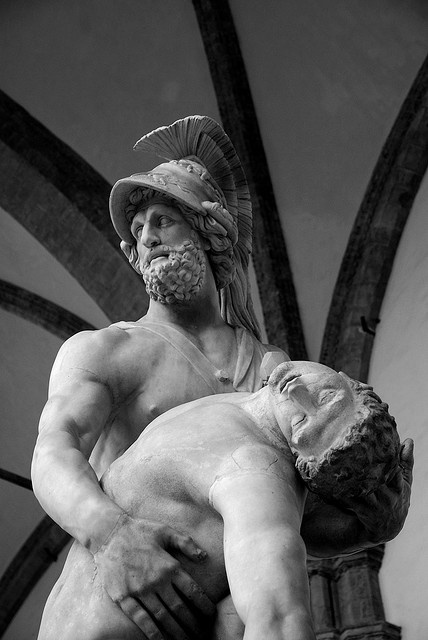
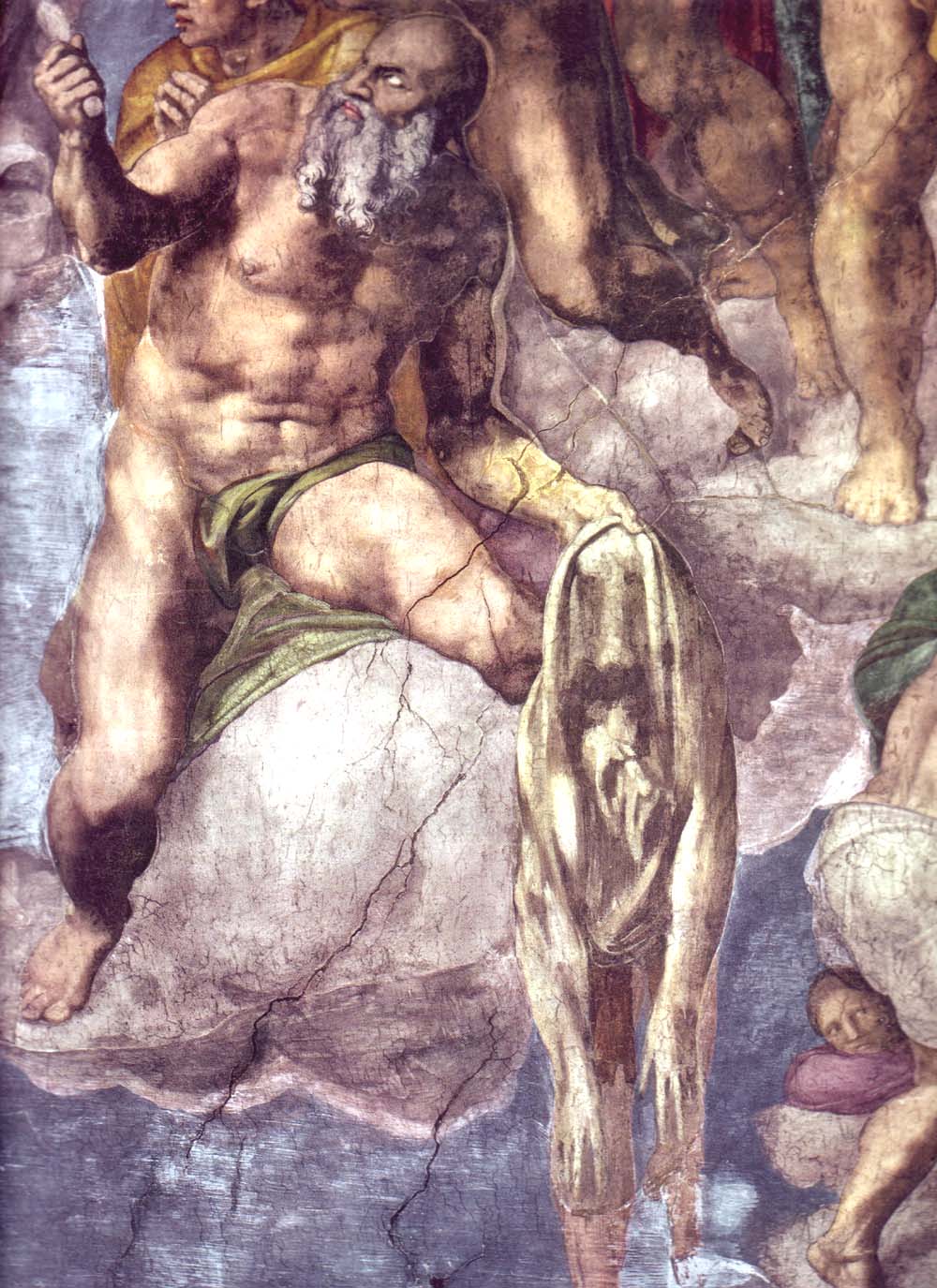
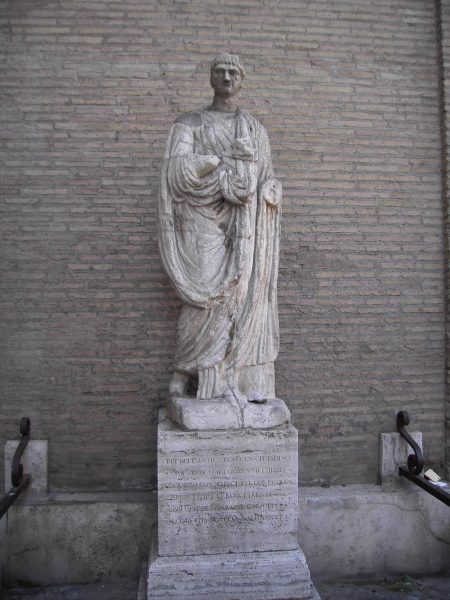
You must be logged in to post a comment.